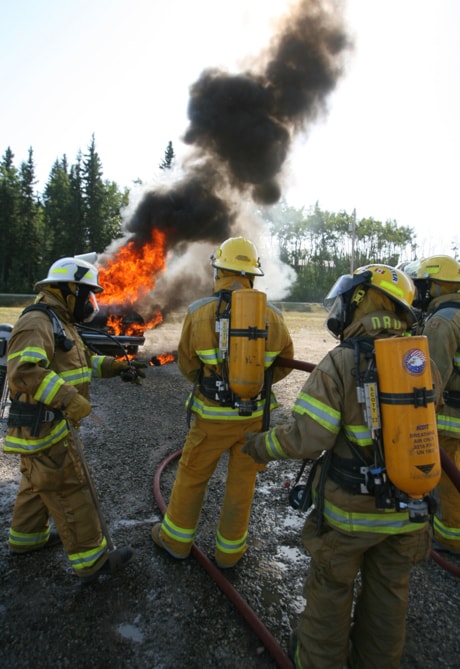Great balls of fire have erupted again from Clearwater County’s public works yard at Leslieville, about 15 minutes east of Rocky Mountain House.
This time, it was intentional.
From Tuesday afternoon until today, members of the Fire Investigation Association of Alberta have been using various techniques to set vehicles on fire — even exploding a couple — to set up some samples for their 2009 Hot Wheels vehicle-fire training school.
There is a note of irony in choosing the public works yard as a site for this year’s school. A few months ago, the county’s Leslieville shop burned to the ground, taking several pieces of heavy equipment along with it.
There’s a new shop now and the hard surface in the yard’s gravelled parking lot provides an ideal location for the school, said Patrick Oslund, regional training and prevention officer for Clearwater Regional Fire Rescue Services.
Wrapping up with final exams and presentations today, the school attracted 40 fire investigators from throughout the province.
Students paid tuitions from $475 to $575 to learn the intricacies of vehicle fires. Fees varied, depending on how late students waited to register and whether they are members of the FIAA.
Fire investigators attending are commonly private contractors working for insurance companies to determine what started the fire and who is at fault.
For example, perhaps a fire is caused by fuel dripping into an alternator because the mechanic dropped his wrench and nicked a fuel line. In that case, the dripping fuel caused the fire and the mechanic is at fault, says instructor Keith Fowler, who has investigated 3,000 vehicle fires and 3,500 mechanical failures.
Along with the investigators, the school gives firefighters a chance to upgrade their vehicle-fire skills, said instructor Ed Rostalski, who retired to open his own private investigation business after 31 years with the Edmonton Fire Department.
Firefighters will attack fires with everything they have, destroying most of the evidence in the process, said Rostalski.
So, while Hot Wheels was set up to train investigators, the fire department that hosts the school gets a chance to practise methods that preserve evidence, he said. The school is moved to a different location every year.
Starting on Tuesday afternoon, FIAA volunteers and instructors set up a series of old vehicles in the Leslieville yard and then burned them, one after another.
Two of the units were hauled to a nearby gravel pit and blown up on Wednesday and a more were preserved for a final demonstration.
Each unit is burned a different way and allowed to burn for a specified times. Then the firefighters move in with their hoses. Squads with the Leslieville Fire Department and the Hellfighters oilfield firefighting team took turns attacking the fires.
Firefighters from small rural departments actually tend to be more conservative than their paid compatriots from city departments, said Rostalski. They don’t have as much access to water, nor do they have the level of backup that is available to a city crew.
Sheldon Mehlbaff, battalion chief for Leslieville, said his department may respond to three or four fire calls a year. Getting an opportunity to host Hot Wheels is a rare opportunity for his crew to learn the proper methods for dealing with vehicle fires, he said.
Jen MacKinnon, recruited fairly recently to Leslieville’s fire department, said the Hot Wheels school as an eye opener.
Watching a car burn is almost spooky, MacKinnon remarked as columns of black smoke billowed from the interior of an aging SUV.
“It was such a surprise to hear,” she said. “They groan.”
bkossowan@www.reddeeradvocate.com
